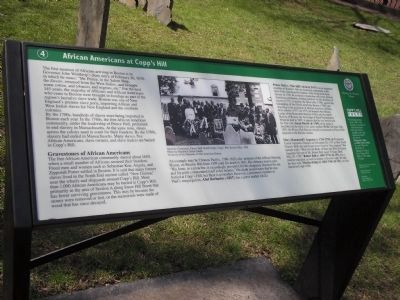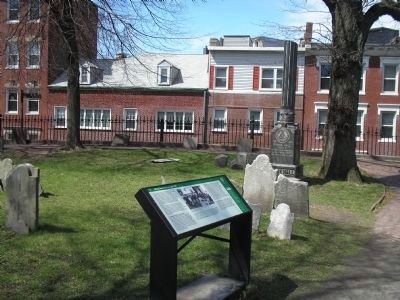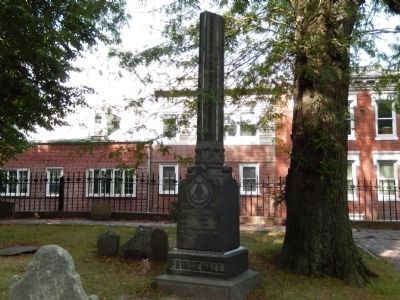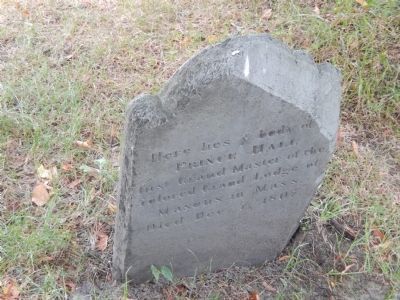North End in Boston in Suffolk County, Massachusetts — The American Northeast (New England)
African Americans at Coppís Hill
By the 1700s, hundreds of slaves were being imported to Boston each year. In the 1760s, the free African American community, under the leadership of Prince Hall, petitioned to end slavery in Massachusetts. At the time, slaves across the colony sued in court for their freedom. By the 1780s, slavery had ended in Massachusetts. Many slaves, free African Americans, slave owners, and slave traders are buried in Coppís Hill.
Gravestones of African Americans
The free African American community started about 1650, when a small number of Africans secured their freedom. Freed men and women such as Sebastian Ken, Angola, and Zipporah Potter settled in Boston. It is said that many former slaves lived in the North End section called “New Guinea,” near the wharfs and shipyards around Coppís Hill. More than 1,000 African Americans may be buried in Coppís Hill, primarily in the area of Section A along Snow Hill Street that has fewer surviving gravestones. This may be because the stones were removed or lost, or the memorials were made of wood that has since decayed.
An example may be Thomas Paul (c. 1780-1831), the minister of the African Meeting House, on Beacon Hill from 1809 until his death in 1831. His obituary read in part, “His fame, as a preacher, is exceedingly prevalent; for his eloquence charmed the ear, and his piety commended itself to his hearers.” His death record states that he was buried at Coppís Hill, but there is no marker. However, a prominent member of Paulís congregation, Abel Barbados (-1817), has a grave marker (A02.)
Prince Hall (c. 1746-1807) (D-16 & D-17) was an important member of Bostonís African American community at the time of the American Revolution. After being freed from slavery in 1769, he assumed a leadership role in the African American community, drafting petitions for the abolition of slavery (1777), to protest the slave trade (1788), against the kidnapping of free Black men from Boston (1788), and objecting to the exclusion of African American children from schools (1787.) In 1775, he founded the African Lodge of the Honorable Society of Free and Accepted
Masons of Boston, the first lodge of black Freemasonry. When he died in 1807, it appears that he was buried near his first wife, Sarah Ritchie (d. 1769), as his name is inscribed on the back of her grave marker (D-16.) On June 24th, 1895, the Prince Hall Masons erected a monument to Prince Hall adjacent to the Richie marker.
Mary (Hammond?) Augustus (c. 1734-1759) (A-7) married Ceasor Augustus (Gustus) on November 28, 1757 at New South Church. Both she and Ceasor were listed as “free negroes.” Her epitaph reads: “Here lies the Body of Mary the Wife of Ceasor Augustus Servant of Mr. Robert Ball Aged 25 Years Died May 28, 1759.” Robert Ball (c. 1699-1774) (D-153) was a mariner and pilot, as well as keeper of Boston Light. He and his first wife, Martha (King) (c. 1683-1765) (D-151), are also buried at Coppís Hill.
Topics. This historical marker is listed in these topic lists: African Americans • Cemeteries & Burial Sites • Colonial Era. A significant historical date for this entry is February 26, 1835.
Location. 42° 22.05′ N, 71° 3.378′ W. Marker is in Boston, Massachusetts, in Suffolk County. It is in North End. Marker can be reached from Hull Street, on the left when traveling east. Marker is located along the walking trail in Copp's Hill Burying Ground. Touch for map. Marker is in this post office area: Boston MA 02113, United States of America. Touch for directions.
Other nearby markers. At least 8 other markers are within walking distance of this marker. Seventeenth Century Coppís Hill (a few steps from this marker); Coppís Hill and the American Revolution (within shouting distance of this marker); From Colonial Burying Ground to Victorian Park (within shouting distance of this marker); Gravestone Art: Skulls, Wings, and Other Symbols (within shouting distance of this marker); Coppís Hill Burying Ground (within shouting distance of this marker); Unusual Gravestones (within shouting distance of this marker); a different marker also named Copp's Hill Burying Ground (within shouting distance of this marker); Welcome to Coppís Hill Burying Ground (within shouting distance of this marker). Touch for a list and map of all markers in Boston.
More about this marker. The top center of the marker contains a photograph of the “Masonic Centennial, Prince Hall Grand Lodge, Coppís Hill, Boston, Mass. 1908. Photo by Hamilton Sutton Smith. Courtesy of the Museum of Afro American History.”
The right side of the marker contains Coppís Hill Facts
ē It is believed that over 1,000 of the burials are people of African descent.
ē Her gravestone epitaph is the only known record of the life of Margaret Colbey (c. 1686-1761) (A-49.) It reads “Here lies the Body of Margaret Colbey, a Free Negro Died
May 4, 1761 aged 75 years.”
Related markers. Click here for a list of markers that are related to this marker. Take a tour of the markers found in Coppís Hill Burying Ground.
Also see . . . Copp's Hill Burying Ground. Details of the Freedom Trail from the City of Boston website. (Submitted on May 13, 2009, by Bill Coughlin of Woodland Park, New Jersey.)
Credits. This page was last revised on January 30, 2023. It was originally submitted on May 13, 2009, by Bill Coughlin of Woodland Park, New Jersey. This page has been viewed 2,278 times since then and 76 times this year. Last updated on July 22, 2009, by Richard E. Miller of Oxon Hill, Maryland. Photos: 1, 2. submitted on May 13, 2009, by Bill Coughlin of Woodland Park, New Jersey. 3, 4. submitted on August 28, 2014, by Bill Pfingsten of Bel Air, Maryland. • Kevin W. was the editor who published this page.



